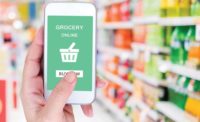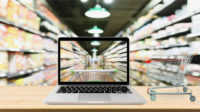2021 Predictions: eCOMMERCE
Fast Growth eCommerce Sales Exceed Expectations; Brands, Retailers Must Adjust
The convenience, reliability, and safety of eCommerce is now more valued than ever

Amazon is the largest online grocery retailer and accounts for 49% of online sales.
PHOTO COURTESY OF: AMAZON.COM INC. (WWW.ABOUTAMAZON.COM)
The events of 2020 have upended almost every norm across the globe. The impact has been felt deeply in the most fundamental areas of our lives, including all things food-related. From supply chain to consumer habits, this year has reinvented how we approach the food we eat, where we eat it, and how we get it. And when it comes to the latter, the convenience, reliability, and safety of eCommerce is now more valued than ever, and there’s no looking back.
Not Just A “Nice-to-Have” Anymore
Online grocery sales were forecast to reach $100 billion in the US by 2025. But because of the events of this year, that trend has been accelerated exponentially. According to a report from Mercatus, eComm sales may well hit as high as $250 billion in just the next five years. The dynamic of a brand’s eCommerce sales has changed from “nice-to-have” to “essential for survival.” And although foodservice sales still face a long recovery, many savvy brands have upped their focus on eCommerce to help offset some of the inevitable losses.
Retailers Continue to Adapt
In this shifting landscape, retailers are adapting how they do business to eCommerce models—and they’re not one-size-fits-all. Whether it’s designating portions of their parking lot to include click-and-collect pick-up zones, upgrading technology, or developing fulfillment solutions to ease clogged store aisles resulting from food delivery services, retailers are finding ways to accommodate their customers’ needs.
Brick-and-mortar market expansion plans have largely been put on hold, while eComm initiatives are expanding. This reinvention goes both ways with the “online-to-offline” addition of a first Amazon Fresh store. Because the bar keeps getting raised for faster delivery and quicker grocery pick-up, retailers are continually improving and adjusting their business models to keep up.
Brands Succeed With Multiple Solutions
Like retailers, brands must diversify their tactics and approach to eComm. Direct-to-consumer sales from owned websites have grown by 117% since the onset of COVID-19. I used to say “No one’s going to visit your website to buy a bag of potato chips.” Not anymore! Today, shoppers are doing just that!
Amazon is the beast of eCommerce. Whether you love ‘em or hate ‘em, they account for 49% of online sales, are by far the largest online grocery retailer. In 2020, their loyal Prime membership base expanded from 105 million to 126 million. They’re a retailer AND a third-party marketplace, and no matter what model you use, it’s highly likely you’ll need to rethink your traditional product pack, pricing and profitability model.
There are also eComm partners who buy through distributors (like ThriveMarket and Vitacost), those who are strictly food delivery (like Fresh Direct and Peapod), and those who are simply delivery methods (like Instacart). Each unique model requires a custom approach to optimize the opportunity they create, and brands are stepping up to this challenge.
New Ways To Shopping
Voice shopping—the use of smart speakers—is taking on more relevance. Now 87.7 Million US consumers own smart speakers, and use them in a variety of ways, including to shop. Brands also must consider their mobile presence, because that’s also become a popular primary shopping tool. Digital media tools are evolving and becoming more sophisticated, and if brands want to become winners in eComm, tapping into these technology trends is key.
Adapt & Respond To Stay Strong
As unpredictable as the course of this next year may be, one thing is certain—for both brands with an existing online presence and those new to eComm, the key to staying strong and viable is the ability to be nimble, adaptable, and responsive in our new shared reality.
Looking for a reprint of this article?
From high-res PDFs to custom plaques, order your copy today!





